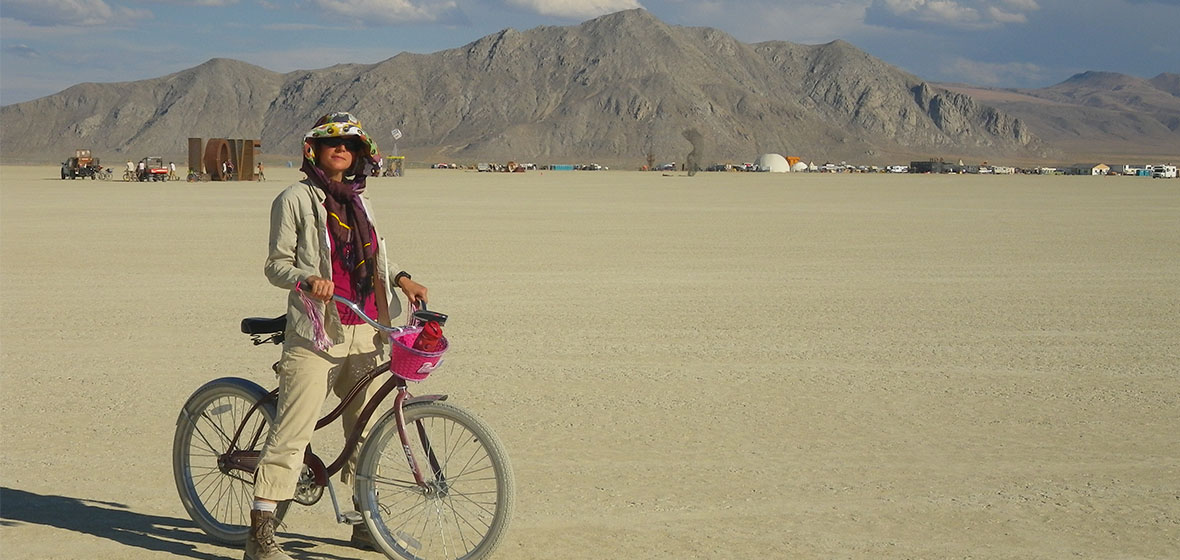When you think of Burning Man you don't necessarily think of academic research, but that's not the case for two University of Nevada, Reno professors. Deborah Boehm, associate professor with a joint appointment in Anthropology and Women's Studies/Gender, Race, and Identity, and Carolyn White, associate professor, anthropology; department chair and Mamie Kleberg Chair in Historic Preservation have teamed up for nearly 10 years to conduct research about the archaeology and ethnography of Black Rock City. They will discuss their research findings at the Nevada Museum of Art on Thursday, Sept. 14 at 6 p.m. The cost to attend is $12 for non-museum members and $8 for members. This program is part of the Nevada Museum of Art's "City of Dust: The Evolution of Burning Man" exhibit on display now through January 7, 2018.
But what does this mean?
Archaeology is usually defined as the scientific study of the human past. And many archaeologists rely on excavation and artifact analysis to do their research. Contemporary archaeology uses the same methods of documentation and analysis of material culture to study the present. Ethnography is a primary way that cultural anthropologists study contemporary human experience.
An opportunity to collaborate
The Burning Man research started as a new project that complemented each of the researchers' existing areas of specialization. White was interested in doing contemporary archaeology and Boehm's research focuses on immigrant communities and social networks across borders.
Boehm and White met at the University in 2007 and decided to collaborate as a way to bridge archaeology and cultural anthropology through the study of Burning Man. In the broader project, they study time, place and the built environment, as well as how Black Rock City and its community is rooted within and transcends the physical place of the Black Rock Desert.
"When I learned of the research Carolyn was doing, I thought that the two of us could partner to carry out interesting work across our subfields in anthropology," Boehm said. "When our field was founded, anthropologists conducted research in four areas-archaeology, biological anthropology, cultural anthropology, and linguistic anthropology-but today the subfields are more distinct. We saw an opportunity to bridge our respective theories and methods to study Burning Man."
Boehm's research focuses on how social and cultural relationships are situated within and outside of geographic places and physical spaces, including how Black Rock City's border is defined and maintained. White's research focuses on how people live in Black Rock City, focusing in part on simarilities and differences from camp to camp.
"One interest of archaeologists across all time periods includes how people dispose of waste," White said. "At Burning Man, things like the location of port-o-potties can affect where people choose to camp. But the way that people organize their trash at Burning Man is of great interest. It is a Leave No Trace event. How do you study a city that doesn't leave any evidence of its existence?"
"As a cultural anthropologist, I focus on the social relationships that form in Black Rock City, Boehm said. "But also how the Burning Man community extends beyond the Black Rock Desert." Burning Man is a short, concentrated experience, but meaningful relationships are built and sustained outside of Black Rock City and throughout the year.
Boehm added, "Many Burners who meet on the Playa form ‘family-like' relationships and continue to be part of these networks after the event ends. For example, there are groups of Burners who spend holidays together throughout the year. Others have had their wedding officiated by a friend they met at Burning Man."
Conducting local research
Researchers travel from across the world to study different aspects of Burning Man, but for Boehm and White they are conducting research in their own backyard.
"The possibility of conducting anthropological work related to this event was very compelling to us," Boehm said. "Burning Man is a national and international event, but it is also an important event for Nevada. As researchers based here, we can see Burning Man's year-round connections to Reno. It is a project well-suited to anthropological inquiry and it also aligns well with the University's land grant mission."












